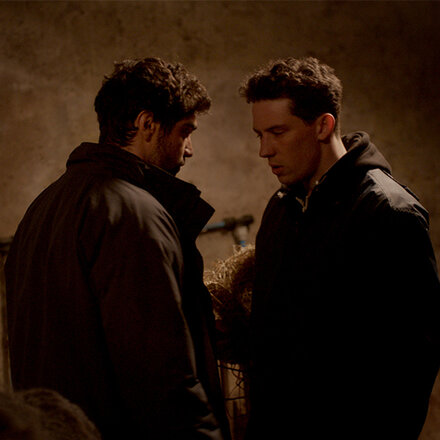Words by Quentin Falk
Angela Allen was barely 21, and just starting out on her career as a fully-fledged Script Supervisor (or ‘Continuity’, as it was called then in British credits) when she was faced with a kind of make-or-break confrontation that, in a sense, would define her own future film role.
The setting was deep down in Sub-Saharan Africa for the shooting of The African Queen (1951), co-starring a pair of Hollywood legends, Humphrey Bogart and Katharine Hepburn. “One day,” Allen recalls, “we had to do a pick-up shot on a sequence we had shot earlier and Katharine said, ‘I was wearing so-and-so.’ And I said, ‘No, you weren’t.’
“I remembered a piece of advice I’d been given by a wonderful script lady who used to work with David Lean and she said, ‘Never dither. Always be positive.’ So I insisted to Katharine, who was 47 at the time and very formidable, ‘No, you wore this.’”
Just when it looked like the situation might be turning ugly, director John Huston – with whom Allen was collaborating on what would be the first of no fewer than 14 films together over the next 30 years – stepped in firmly with, “We’ll do what Ange says,” gently telling Hepburn, with his legendary charm, to “go and change.”
"In those days, your notes had to be really copious; they described everything, every movement. There were no computers, video or Polaroids then. You had to be so conscientious and careful."
Thrilled by his loyalty, Allen was, however, still a little fearful about the situation. “Of course, there was no way of seeing ‘rushes’ where we were so I remember sending a note saying, ‘Please will you phone; will you tell me if I was right.’ Well, thank god, I was.”
Allen, born and brought up in London between the wars, flirted with the idea of becoming an actress, then a make-up artist or costume designer (“trouble is I couldn’t draw”) before getting her first job as a junior receptionist at a leading talent agency. A trip out to Denham Studios where Olivier was shooting his Hamlet gave her the film bug; not long after she was working as a Continuity assistant/trainee at the altogether less glamorous Isleworth Studios, another corner of the Korda empire.
Two weeks shooting freezing nights on 2nd Unit in the dockland wilds of Wapping was an eye-opener and probably good training for an even more remote location to come on Bonnie Prince Charlie (1948) in Scotland. She was not yet 20 when she became official “Sewer Queen” on the second unit of The Third Man (1949) in Vienna, striking up a good friendship with assistant director Guy Hamilton while also learning much from an established master in director Carol Reed.
“Carol directed everything, and I was so lucky at that stage to work with someone who knew exactly what he was doing. When we were back from Vienna, I used to take notes for him every night in the rushes and for the cutting rooms, which was a great learning process. In those days, your notes had to be really copious; they described everything, every movement. There were no computers, video or Polaroids then. You had to be so conscientious and careful. If you wanted to go to the bathroom, you’d have to stick up your hand and ask if you could leave the set. It was like being back at school,” she laughs.
She thinks it was probably Guy Hamilton who enabled her entrée to The African Queen which, after she had managed to elude the too-close attentions of producer Sam Spiegel, also provided the exotic beginning to a 14-film relationship with John Huston which included Moulin Rouge, Moby Dick, The Man Who Would be King and, of course, The Misfits.
As if the duties of Continuity weren’t enough, after doubling once in a swimming shot for Ava Gardner on an earlier picture, Pandora and The Flying Dutchman (1951), Allen had to step up again on The African Queen, this time for Hepburn, crouching down at the boat’s tiller for an overhead shot. Then there was time later on when she had to double Eddie Albert’s bottom on The Roots of Heaven (1958).
“My advice is, and always has been, to take an intelligent interest in the script and point out any inconsistencies you see in the script to the director, but try and do it as tactfully as possible as directors’ egos are easily bruisable...”
If the practical joke-playing Huston – “and no, I was never his mistress” – was her most prolific collaborator, Allen would also do repeat business down the years with the likes of Sidney Lumet (”the most disciplined and efficient director I ever worked with”), John Frankenheimer and Franco Zeffirelli, with whom she worked on her final credit, Callas Forever, in 2003. Two years after that, she was given BAFTA’s Michael Balcon Award for Outstanding British Contribution to Cinema to add to a Queen’s Birthday Honours’ List MBE in 1996.
If facing down Hepburn on an argument over clothing was one of her prouder moments, perhaps the hardest was working on The Dirty Dozen (1967). “Trying to do Continuity when there were sometimes at least 12 men round a table is difficult enough but in this case it was also to do with Robert Aldrich’s ‘coverage’. Everything had to be 360 degrees. We got to over 2,000 takes on the slate board; multiply that by three because we always had three cameras going and you can see how enormous the coverage was. Quite unnecessary, really.”
Allen, who helped change, in the UK, the description/status of her crucial job from Continuity (Girl was almost an understood) to Script Supervisor – “probably “Script Continuity” is the more accurate description” – and, more importantly, the tax category from PAYE to Schedule D from the back end of the Seventies, has her real concerns about the nature of the job today.
“I think a lot of people now treat the job as if all it needs is a note taker or just a glorified secretary,” she says, agreeing that the current proliferation of film gaffe compilations tends to underscore her point.
“The point of the job is to be a help to the director and see that the film can be edited as smoothly as possible in as many versions, if shots match, that is possible. The job is to be the liaison between director and editor and generally helpful to all departments who ask you questions, whether it’s props, costume, make-up, camera, sound.
“My advice is, and always has been, to take an intelligent interest in the script and point out any inconsistencies you see in the script to the director, but try and do it as tactfully as possible as directors’ egos are easily bruisable...”






